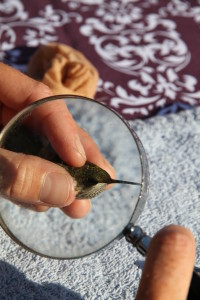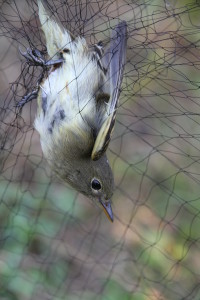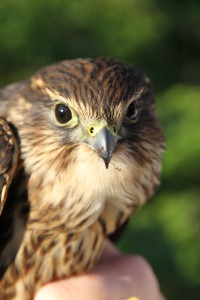A Marsh That Matters – Temiskaming Shores
A Marsh that Matters – Continental Flyway Stopover
Volunteers – Birders’ Paradise
“Hummers” and New Species
Bird Banding Centre – Photographers Dream Destination
by Back Roads Bill
Not sure if this is a story about a wetland that matters or listening to hummingbird’s heart beat? These are real “hummers” alright, not the once iconic, 4X4 luxurious off-road vehicle.
And for the adage, “Birds of a feather flock together,” it is not necessarily true.
If you are a “birder” or not, the Hilliardton Marsh just north of Temiskaming Shores (New Liskeard) comprises 728 hectares (1798 acres); it is designated as a provincially significant wetland and wildlife area. A marsh is different from a swamp, fen or bog, it is an area of low-lying land that is flooded in wet seasons and typically remains waterlogged at all times. It is also the home for the Hilliardton Marsh Bird & Wetland Research & Education Centre (HM). Around for about two decades it remains a work in progress indicative of a fledgling volunteer organization. There is, at present, a small building with no washrooms and limited parking. But it is one of two observatories in Northern Ontario, the other being Thunder Cape Bird Observatory east of Thunder Bay. It is home to more than 600 species of waterfowl, songbirds, mammals, fish and plant life. HM is continentally significant for waterfowl migrating to and from the James Bay and Hudson Bay lowlands. Because of the five-star habitat it is an important stopover for migrating birds.
The property was developed by Ducks Unlimited (DU). It is the leader in wetland conservation that is critical to waterfowl, wildlife and the environment. Prior to the restoration of the marsh by DU the agricultural landscape was dry and provided virtually no habitat for waterfowl or other wetland-dependent species. The wetlands had lost 85% of its original wetland habitat, HM now it has five engineered cells with elevated berms just off of the Blanche River, the source of the diverted water. There is approximately 11 km of trails for bird and wildlife viewing and the berms provide great vantage points for viewing and photography.
A Marsh that Matters
 HM provides opportunities for school groups and the general public to learn about birds and wetlands, and facilitates and conducts research about the marsh and the birds and wildlife that make it their home.
HM provides opportunities for school groups and the general public to learn about birds and wetlands, and facilitates and conducts research about the marsh and the birds and wildlife that make it their home.
HM is becoming inducted into the Canadian Migration Monitoring Network. The national organization involves the cooperation of bird observatories across the country. Bird Studies Canada is developing standards for data collection, preparing computer software to aid with data entry for migration counts, and developing analysis programs to calculate trends automatically using the data from each station. The stations, like HM, are actively involved in the actual field work, counting and banding birds. Much of this work is done by volunteers. And so is the case of HM, big time.
Bruce Murphy, a local high school teacher, is a founding HM pioneer. His own passion developed during his own Grade 6 field trip to the Toronto Island field school where a single chickadee was banded. “I was hooked, what better way is there to touch nature.” For many years his alternative outdoor education program did much of the work until it was “canned” by the school board. Many volunteers and student programs have picked up the slack.
What attracts the volunteers? “It is a Wetland Center of Excellence as designated by DU. We were fortunate to become one of the first in Canada, and the first program in Ontario, to be supported by DU,” said Bruce. “In this way DU supports a program called ‘Green Street,’ which assists teachers and students who wish to learn more about the environment.”

Warbler in the mist net
“During the banding season in the spring and fall, District School Board Ontario North East classes from grades 4 to 12 make appointments and come out to HM for the day. They split up into two groups – a bird group and an aquatic group. The bird group goes into the banding shed where they learn about why people band birds. They also get to hold them and ask any questions they want. The aquatic group goes over to the floating dock and they catch insects that spend part of their lives in the water and they try to identify them.”
There is an emerging theory related to the mist netting. The HM principals have noticed that often birds in a mixed flock end up in a single net at the same time. It is a theory that Bruce and others have about different bird species travelling together, perhaps even having specific roles within the flock, a question that needs to be further researched. They are thinking about tracking what birds that are caught at the same time to identify patterns.
Jonne Goddard is Vice-President on the HM Board of Directors and a local elementary school teacher. She is part of the dynamic duo with Bruce. Together they are a dynamo, an old school word. She does this because, “Part of my passion about banding is to see the look on young and old alike when they hold a bird for the first time. You can never anticipate the impact it will have but you know they are forever changed.”
Her own students call themselves “the school of flock.” She said, “They do a daily bird census around as well as band snow buntings in the winter in a field near the school (Kerns Township) and assist me with hummingbird banding in the spring. They are also active volunteers at the marsh. This winter will be our fifth year studying the migration habits of snow buntings, and the fourth year that Kern’s Public School students have been one of the leading research partners involved in this important initiative.” Experiential teaching and learning at its best.
True Hummers
Their heart rates can reach as high as 1,260 beats per minute, a rate once measured in a blue-throated hummingbird, with a breathing rate of 250 breaths per minute.

Humming bird…closeup
In the summer of 2011 Goddard and Murphy travelled to West Virginia, to earn their hummingbird banding permits. “We scribed, made bands, trapped and handled birds, and basically learned more than I could ever have imagined about hummingbirds, while toiling away putting tiny bands on tiny legs. After banding 300 buzzing birds, we returned to our northern home and managed to band a few straggling hummers before they headed off on their fall migration. It was such a thrill to band my first northern ruby-throats.”
Hummingbird banding has become one of HM’s most successful banding programs. “We have had many birds return year after year to the backyards they were banded in. In fact we have had several hummers that were banded as babies in our own back yard, return to the place of their birth the following year to be recaptured by us,” said Joanne. “It is amazing to think that every time I hold a recaptured adult hummingbird that I banded the previous year in my yard as a baby, that this tiny being has made its way to Central America long after the other adults birds in the area have left on their own migrations. It takes flight, all by itself, without the help of its parents or the protection of a flock, and somehow finds its way. This tiny bird in my hand, that visits my backyard feeder, every 20 minutes to refuel, has made its way to its wintering grounds where it was met by others of its kind to spend a few months feeding, only to turn around and make the same journey back, this time as an adult, to the place of its birth; at my very own Northern Ontario garden!” To date HM banders have banded 400 northern hummingbirds that have the potential to show up basically anywhere along their southern journey.

A banded merlin
She said, “HM employs a part time executive director and a bander (Chris Sukha, a assistant pastor from Field) that works along with Murph every spring and Fall to help out with migration monitoring, and this year we managed to fund a student intern (Nicole Richardson from Nipissing University). We are also involved with the stewardship youth ranger program with the Ministry of Natural Resources and Forestry.”
Owl banding will soon start. Bruce said, “We have had over 50 owls banded at the marsh that have been discovered by other banders in Ontario and in the USA. Many travel to destinations in the Eastern States. The work of banders has established that Saw-whets are actually the most abundant owl in North America. It is just that they are rarely seen, preferring to hide during the day in the heart of the boreal forest close to the trunks of trees. The secret to catching these owls is to play a recording of their call. This technique is called using an audio lure. The reason we have focused on Saw-whets is because we are part of a group called ‘Project Owlnet’ and originally researches attempted to catch owls without using the tape – a technique referred to as passive netting. At the peak of the season, we optimistically expect 20-30 owls on a good night.”
(Pers. Comm. While attending the recent ‘Garden Party’ event, Joanne held a juvenile ruby throated hummingbird to Back Roads Bill’s ear. Its heart beat sounded like a jet engine, that very continuous, vibrating sound you make when you put your tongue to the roof of your mouth. Imagine these little birds flying nonstop for twenty-two hours across the Gulf of Mexico alone! A better experience than TV or YouTube. During the day more than 300 people attended, 120 birds representing 26 species were banded, including the 147th identified species banded at the marsh, a merlin. I will be back.) HM is 180 km north of North Bay, 15 km southeast of Englehart. From the south turn east on Highway 569 and travel 11.9 km (over the bridge at Hilliardton) to Wool Mill Rd. It is located in the scenic Belle Vallée, take a back roads drive through the Little Clay Belt, a rural farming area with an expansive view.
Hummer vehicles were designed and built to travel to the ends of the Earth to let you test your limits when you get there. Having a Hummingbird, that has travelled from these “ends,” next to your ear, lets you connect with the outdoors in a way you never dreamed possible. Nature counts more than ever, the Hilliardton Marsh is an ecologically important wetland and a destination for birds and visitors. Make the heartfelt connection, take in an event or program, maybe get your feet wet, hold a bird, and be a part of the migration.
Google Map